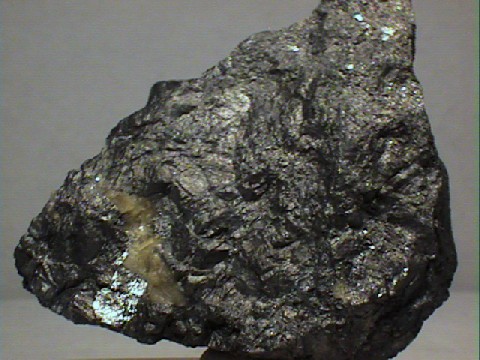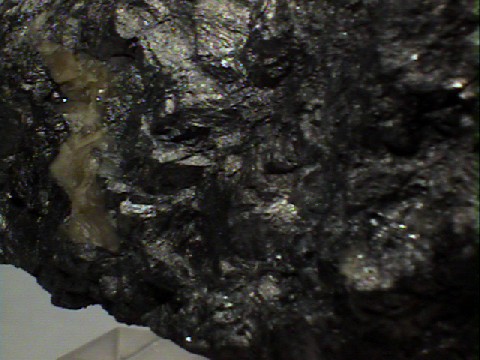 THE
MINERAL ULLMANNITE
THE
MINERAL ULLMANNITE
- Chemistry: NiSbS, Nickel Antimony Sulfide
- Class: Sulfides
- Group: Cobaltite
- Uses: As a very minor ore of nickel and as mineral specimens.
Specimens
Ullmannite, which is named for the German chemist and mineralogist, J. C. Ullmann, is a rare nickel mineral that belongs to the Cobaltite Group of minerals. Most members of this group are rare to extremely rare except for cobaltite. Like other members of this group, ullmannite can form nice crystals that are either cubic, octahedral, tetrahedral or even pyritohedral, the classic crystal form of pyrite.
Ullmannite's symmetry is isometric and it has the same unique symmetry as pyrite, skutterudite and cobaltite. They all belong to the Diploidal Class, a class that, although isometric, lacks four fold symmetry. The ullmannite structure is similar to pyrite's except that the S2 groups of pyrite are replaced by Sb-S groups in ullmannite. The antimony and sulfur are bonded together with a covalent bond. If the antimony and sulfur have an ordered arrangement (such that all of the antimony atoms are to the left or all are to the right of the Sb-S bonds), then the symmetry is reduced to the lower symmetry of the Tetartoidal Class; 2 3. This is the lowest symmetry class of the isometric system and contains only 4 three fold and 3 two fold axes. Most ullamnnite has an unordered antimony-sulfur arrangement and therefore belongs to the higher Diploidal Class which contains 4 three fold and 3 two fold axes, three mirror planes and a center of symmetry. Even though ullmannite is known to no longer belong to this class, a synonym for the Tetartoidal Class is the term: Ullmannite Type.
Ullmanite is very similar to a nickel arsenic sulfide called gersdorffite. Gersdorffite's formula is NiAsS and shows the substitution of arsenic for the antimony in ullmannite's formula. The two elements are themselves very similar and therefore do not cause appreciable differences in their respectivly enriched minerals. The rarer ullmannite usually has some arsenic in its chemistry anyways. The two minerals are almost indistinguishable by ordinary means.
PHYSICAL CHARACTERISTICS:
- Color is steel gray, silver to tin white.
- Luster is metallic.
- Transparency: Crystals are opaque.
- Crystal System: Isometric; bar 3 2/m (if an ordered structure is found then 2 3)
- Crystal Habits include cubic, octahedral, tetrahedral and pyritohedral crystals as well as massive and granular forms.
- Cleavage is good in three directions forming cubes.
- Fracture: Uneven.
- Hardness is 5 - 5.5
- Specific Gravity is 6.6 - 6.7 (heavier than average for metallic minerals)
- Streak is black.
- Other Characteristics: Crystals are sometimes striated.
- Associated Minerals include
pyrite,
sphalerite,
niccolite , quartz,breithauptite , calcite, galena and some iron minerals. - Notable Occurrences include the type locality of Freusburg, Siegen, Westphalia, Germany as well as other localtions in Germany; Settlingstones Mine, North Pennines, Britain; Lolling, Carinthia, Austria; France; Brancepeth Colliery, Durham, England and Gunnison County, Colorado, USA.
- Best Field Indicators are crystal habit, cleavage, hardness and density.



